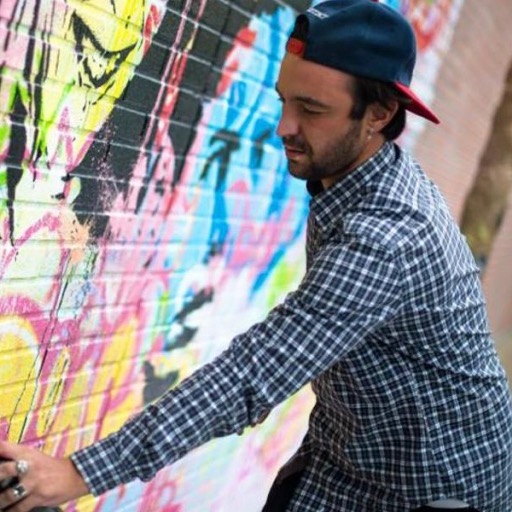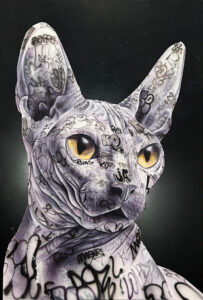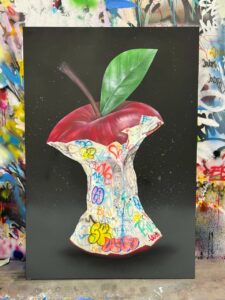< retour aux artistes
< volver a los artistas
< back to artists

Biographie
Biography
Biografía
The Praise of Vandalism
Onemizer was born in 1987 in the South of France. He lives and works in the Parisian region. Onemizer is like a DJ who has traded his turntables for canvas and palettes. He stirs up excitement with his remixes of legendary images, a kind of “Greatest Hits” of street art whose most danceable basslines or particularly exhilarating riffs we love to hear again and again.
The story begins on the fringes with flops on the outskirts of the railway tracks at the end of the line, beyond the orange card zone. And then, there’s the discovery of canvas. A book circulating to the capital city leads to a call from a Parisian gallery, and he’s suddenly crowned the little prince of street art. “What I love is working in a trance,” he explains. “What really pleases me is spending eight hours on a canvas, doing, redoing, achieving the perfect effect. At the same time, I like it when there’s a flaw, when the viewer can see the energy, the spontaneity.”
How to reach a trance? No substances or music: “I turn on the TV. I listen to the voices, I don’t know what’s on, but I need that presence. It dates back to the time when my apartment was like the hangout spot for the youth; any of my buddies would show up, play, talk, smoke, and I would stay painting next to them.”
To explain his current technique, Onemizer develops a clear vision: a character or symbol he portrays in a realistic style, and then an accumulation of tags, flops, and fat cap strokes, as if the entire suburb had descended to give its opinion on his initial piece. He calls it the “wall of free expression,” the “praise of vandalism.”
Onemizer plays with signs and icons of Pop Culture. Success follows. “When I meet my buddies from the suburbs, I don’t even dare to tell them how much one of my paintings sells for.”
However, he refuses to take the easy way out: “There’s an adjustment period; when you start selling, you feel really good. But when there’s a lull, you enter a phase of depression. I’m quite anxious.” That’s the paradox of Onemizer. He feels more and more confident in his technique and then questions the direction he should take to make the most of this skill he now masters. “I was the outsider, but now I have this little notoriety that should allow me to renew myself. I’d like to move towards the abstract or convey a more biting political message.” Banksy remains his absolute reference. But he is not blinded by the beatification of the patron saint of street art. “In the end, I also like Mr. Brainwash: art for nothing, art for business, but I like it.” Contradiction? No, sincerity.
So with age and now a family, the vandal thinks about how to build a credible artist career between the pitfalls of repetition and the illusions of recognition by the arbiters of good taste. He has given up tagging but confesses to often wanting to go out after 2 in the morning to commit a chrome in the dark on the outskirts of the city. “I don’t do it anymore because I don’t want my wife and kid to come pick me up at the police station.” But he immediately confesses with relish: “However, yes, on vacation, when I’m abroad, there, no problem, I go out and continue to graffiti.”
For the collective show “Rock,” Onemizer is experimenting with a new approach with black and white canvases. “I want to explode until I’m reminded to stop.” To order? No worries. This vandal is free, and he’s not about to be locked up.







